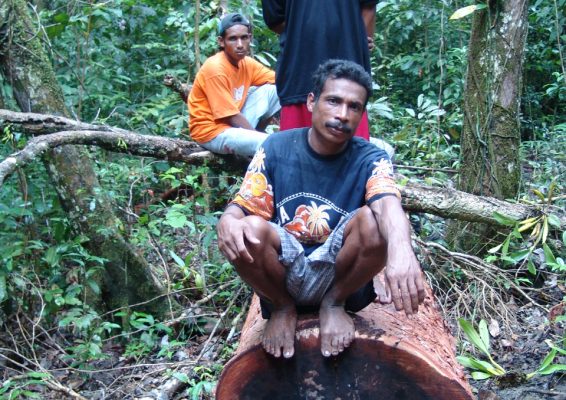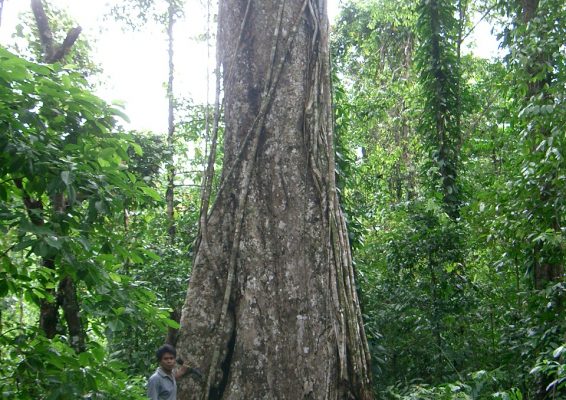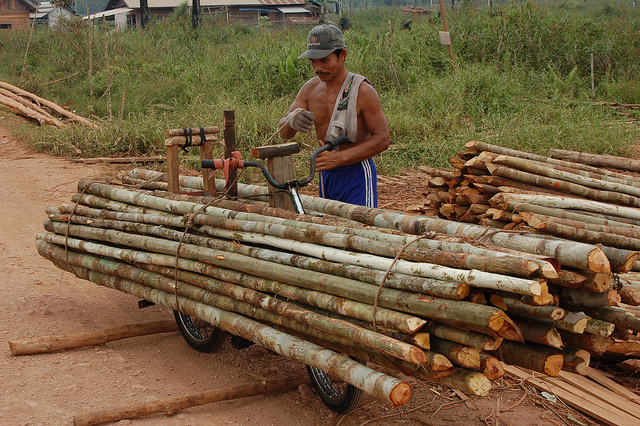Indonesia is down to its last tropical seasonal forests – and they’re entirely unprotected.
The forests are found in the Tanimbar archipelago in Maluku Province, due directly north of Darwin, Australia, on the border of the Banda and Arafura seas. One of the most unconnected parts of the archipelago, Tanimbar has no formal port of entry, and population lingers around 100,000 scattered across the 30 or so islands in the group.
“It’s very expensive to work and go there,” says Center for International Forestry Research (CIFOR) Director General Robert Nasi, who has kept a watchful eye on the islands along with Yves Laumonier, scientist at CIFOR and the Center for Research and Agronomy and Development (CIRAD), since the early 2000s. “Once, we got stuck in Ambon on the way when all flights were cancelled.”
This isolation has long been a shield of protection for the islands, keeping the forest cover constant for decades after local communities revolted against logging companies that came in during the era of Indonesia’s former president Suharto. But recent satellite imagery shows deforestation from logging companies that have returned, threatening the islands’ natural and social ways of life. In the face of this inevitable development, Laumonier recently published a research article co-authored by Nasi calling for national protection of these endangered forests, more research on their fragile natures, and an approach to development that will support the land and people both.
I’m afraid if they use the same logging techniques as in Sumatra or Borneo, it won’t work well because it’s a completely different ecological condition
STAYING DRY
The research focuses on the largest (by far, at 3,300 square kilometers) of the islands, Yamdena, which is shared by a trio of forest types: moist deciduous, dry deciduous and seasonal evergreen. Filled with some of the world’s most valuable timber trees – Pterocarpus indicus, more commonly known as rosewood; and Intsia bijua, merbau – the forests’ Asiatic flora leads the scientists to believe that its ancestors came from the north and west, with now-gone seasonal brethren once in eastern Java, Flores the northern reaches of Timor.
“If you move from one forest type to the other, you know. It’s somewhat hard to tell with satellite images, but if you walk in the fields, you can see, especially in the dry season,” says Nasi. “The driest ones shed their leaves completely.”
In a part of the world more accustomed to humid climes, it’s this aridity that makes the landscape so unique – and challenging. Freshwater comes from a few main watersheds feeding a small network of rivers, which, if disturbed, can easily incite water scarcity for the 40 villages on the island. And given the island’s foundation on coral limestone, the forests play a crucial role in water maintenance by holding water in the soil and keeping the soil in place during tropical storms.
Due to its propensity for erosion, basic pH level and rocky underbelly that blocks deep rooting, the soil is a very difficult base for regrowth. Once the environment here is disturbed, it’s extraordinarily difficult to restore and rehabilitate.
“In places like Flores, you have savanna-like landscapes now,” says Laumonier, analogizing Yamdena. “It was obviously forested before, because we have records from the Dutch that it was forested at a time. But it’s very fragile. If you cut the forest and do too much agriculture and burning, it won’t come back. It becomes dense shrubs and savanna.
“And here, you can see it proves wrong the assumption on which Indonesian forest status and function classification is built: that there’s less erosion on under drier climate,” he continues. “When short but intense rains come, everything washes down to the sea.”
An upside to the dryness, though, is that it makes monitoring easier; cloud cover rarely blocks the satellite imagery. This alerted the scientists to when companies came in around 2014 and began logging the eastern side of the island.
“I’m afraid if they use the same logging techniques as in Sumatra or Borneo, it won’t work well because it’s a completely different ecological condition,” says Laumonier. “And now we can see on the satellite that they’re going further inland, reaching the main river source. It’s really the worst place to work.”
The remoteness of the island appeals to the logging companies, the scientists say, because it makes their operations more secure, hidden from scrutinizing eyes. And, because there are no national protected areas, the island could theoretically be commercially logged in its entirety.


LOCAL LOOKOUT
Laumonier first became fascinated by the Tanimbar islands when reading about them in Forgotten Islands of Indonesia, a photo-heavy book on Malukan culture by anthropologists Nico de Jonge and Toos van Dijk. “I don’t know why, but it was like an adventure in my mind,” he recalls, “and then suddenly I’m there.”
Tanimbar’s past is storied with tribes of headhunters until missionaries came in the end of 19th century, and the local seafaring culture is immortalized in the constructs of village governments, with leadership as captains, pilots and other ship hands as you go down the ranks.
Land and water management – especially in coastal areas – is largely still governed by the traditional Malukan sasi systems of rotational no-go zones and quotas, or by a slightly different ‘church sasi’ where “you don’t get fined by ancestors, you get fined by the church,” says Laumonier. It’s this deep-seated connection to the land that has made locals largely resistant to outside companies coming in.
“Sometimes I get a phone call from local village leaders saying that this or that logging company wants to come back. And they ask if I can call the EU for help,” laughs Laumonier.
Yet the recent uptick in logging, which started in the most remote and undeveloped parts of the island, shows that it’s hard to stay immune to development’s benefits – especially in a region as poor and under-populated as here. To this end, the main point of the article isn’t to rope off the island from logging and development, but to put safeguards around the critical forest areas that need to be protected by national law.
And more generally, the article aims to wave a flag that Tanimbar is changing and needs support along the way. While tropical seasonal forests are among the world’s most threatened landscapes, they’re also among the most under-researched.
“To change the way you log here, there is a need to do more research on silvicuture, ecology and regeneration of these seasonal forests” says Laumonier.
He and Nasi think logging should come primarily through community-based forestry enterprises, done at a small scale with respect for boundaries of areas that should and shouldn’t be logged, and under what conditions. They also make a call for land-use planning in other income-generating areas, such as mangroves that can be maintained with sustainable shrimp farming.
Laumonier recalls one story that bodes well for Tanimbar of a guy who went to work in logging in Papua, then returned with a chainsaw. He opened a small business in his village, which the scientists now refer to as the ‘loggers village’ because it has become so specialized. “And they have nothing to do with a company,” says Laumonier. “They go to the forest, cut a few trees, make planks for the local market.” With a little help, they could easily organize their trade with Darwin, he says, allowing them to reach a better market in one or two days by boat, rather than the week or so it takes to reach Surabaya.
“And for them, that’s enough.”
We want you to share Forests News content, which is licensed under Creative Commons Attribution-NonCommercial-ShareAlike 4.0 International (CC BY-NC-SA 4.0). This means you are free to redistribute our material for non-commercial purposes. All we ask is that you give Forests News appropriate credit and link to the original Forests News content, indicate if changes were made, and distribute your contributions under the same Creative Commons license. You must notify Forests News if you repost, reprint or reuse our materials by contacting forestsnews@cifor-icraf.org.
